.


UNITED STATES DEPARTMENT OF THE INTERIOR
Fred A. Seaton, Secretary
NATIONAL PARK SERVICE
Conrad L. Wirth, Director
HISTORICAL HANDBOOK NUMBER TWENTY-SIX
This publication is one of a series of handbooks describing the historical and archeological areas in the National Park System administered by the National Park Service of the United States Department of the Interior. It is printed by the Government Printing Office and may be purchased from the Superintendent of Documents, Washington 25, D. C. Price 25 cents.
GEORGE WASHINGTON BIRTHPLACE
National Monument
Virginia
by J. Paul Hudson
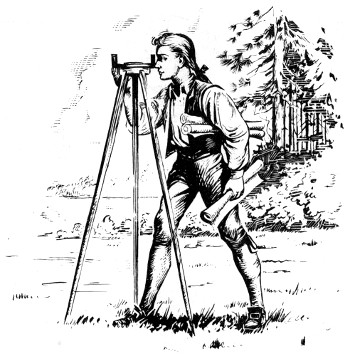
NATIONAL PARK SERVICE HISTORICAL HANDBOOK SERIES No. 26
Washington, D. C., 1956
The National Park System, of which George Washington Birthplace National Monument is a unit, is dedicated to conserving the scenic, scientific, and historic heritage of the United States for the benefit and enjoyment of its people.

Contents
- Page
- JOHN WASHINGTON 5
- LAWRENCE WASHINGTON 6
- AUGUSTINE WASHINGTON 10
- Early Life 10
- First Marriage 10
- Purchase of Popes Creek Farm 12
- Building the Birthplace Home 12
- The Birthplace 12
- Second Marriage 14
- Virginia in 1732 14
- GEORGE WASHINGTON 16
- THE DISASTROUS FIRE 22
- A CENTURY OF NEGLECT 23
- THE SAVING OF WASHINGTON’S BIRTHPLACE 27
- GUIDE TO THE AREA 33
- HOW TO REACH THE MONUMENT 43
- ABOUT YOUR VISIT 43
- RELATED AREAS 44
- ADMINISTRATION 44
- SUGGESTED READINGS 44

George Washington, colonel of the Virginia militia at the age of 40. From a painting by Charles Willson Peale. Courtesy, Washington and Lee University.
GEORGE WASHINGTON
”... His integrity was most pure, his justice the most inflexible I have ever known, no motives ... of friendship or hatred being able to bias his decision. He was, indeed, in every sense of the words, a wise, a good, and a great man.... His heart was not warm in its affections; but he exactly calculated every man’s value and gave him a solid esteem proportioned to it.... Although in the circle of his friends ... he took a free share in conversation, his colloquial talents were not above mediocrity, possessing neither copiousness of ideas, nor fluency of words.... Yet he wrote readily, rather diffusely, in an easy and correct style.... On the whole, his character was, in its mass, perfect, in nothing bad, in few points indifferent; and it may truly be said, that never did nature and fortune combine more perfectly to make a man great, and to place him in the same constellation with whatever worthies have merited from man an everlasting remembrance. For his was the singular destiny and merit, of leading the armies of his country successfully through an arduous war, for the establishment of its independence; of conducting its councils through the birth of a government, new in its forms and principles, until it had settled down into a quiet and orderly train; and of scrupulously obeying the laws through the whole of his career, civil and military, of which the history of the world furnishes no other example....”
Thomas Jefferson in a letter to Dr. Walter Jones, January 2, 1814, more than 14 years after Washington’s death.

A scene along Popes Creek, 200 feet from the birthplace home of George Washington.
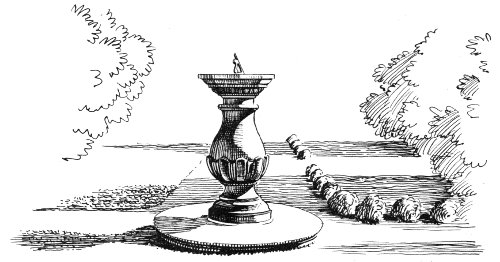
“A place of rose and thyme and scented earth,
A place the world forgot,
But here a matchless flower came to birth—
Time paused and blessed the spot.”
—Inscription on the sundial in the herb garden, Washington’s Birthplace.
The story of the Washington family plantation in Westmoreland County, Va., where George Washington was born on February 22, 1732, may be divided into 3 main parts. The first relates to the activities of the early Washingtons who lived on the plantation during the latter third of the 17th century and fourscore years of the 18th century—a period covering 115 years. During that time the plantation between Bridges Creek and Popes Creek grew; successive members of the Washington family became prosperous planters, acquired large landholdings, and attained important civic and political offices in their county and colony. The climactic year of this first period was 1732—the 6th year in the reign of King George II and the 125th year in the history of the colony—when George, the son of Augustine and Mary Ball Washington, was born. The period ends during the American Revolution when the home in which George first saw the light of day accidentally caught fire, burned to the ground, and was abandoned as a homesite.
The second period spans a hundred years—a century when the birthplace site was neglected, and was all but forgotten by a growing nation which showed little or no interest in preserving the birthplace of its great military leader and first president. Wild honeysuckle and bramble thickets covered the foundations of the burned home; the place was forgotten for so many years that knowledge of the exact location and use of many of the plantation buildings became lost.

PATERNAL ANCESTRY OF GEORGE WASHINGTON
Col. JOHN WASHINGTON
Born 1632, founder of Washington family in Virginia, 1656-57.
Died Sept. 1677.
ANNE POPE
Daughter of Lt. Col. Nathaniel Pope.
Married 1658, died 1669.
Capt. LAWRENCE WASHINGTON (1)
Born Sept. 1659, Westmoreland Co., Va.
Died 1698.
MILDRED WARNER, GEORGE GALE (2)
Daughter of Augustine Warner.
Married 1690, died 1701.
Capt. AUGUSTINE WASHINGTON
Born 1694.
Died 1743.
(1) JANE BUTLER
Born 1699.
Married 1715.
Died 1729.
Butler, died young.
Lawrence, of Mt. Vernon.
Augustine, inherited Wakefield.
Jane.
(2) MARY BALL
Daughter of Joseph Ball.
Born 1708.
Married 1731.
Died 1789.
GEORGE WASHINGTON
Born February 11, 1732 (Old Style); or February 22, 1732 (New Style).
Married Jan. 19, 1759.
Died Dec. 14, 1799.
MARTHA (DANDRIDGE) CUSTIS
Widow of Daniel Parke Custis.
Elizabeth.
Samuel.
John Augustine.
Charles.
Mildred.
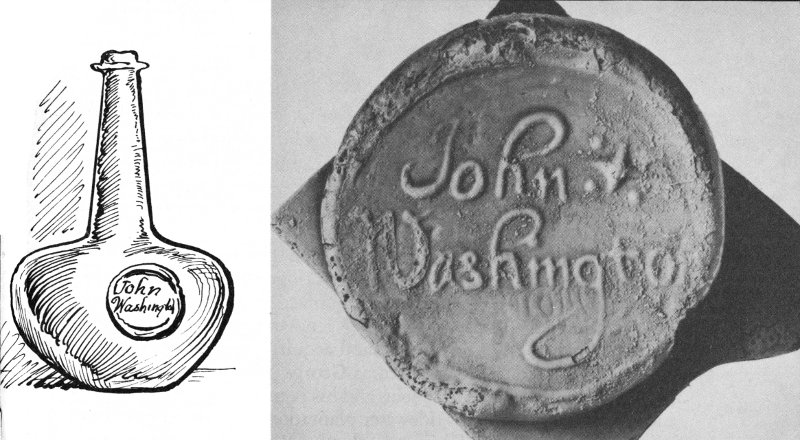
Wine bottle seal found near homesite of John Washington, and drawing of a bottle of the period.
The third and last period of the story covers the years when the Federal Government, various individuals, and patriotic organizations became interested in preserving the historic site; a period culminating in the preservation of the ancient plantation by the Wakefield National Memorial Association and the United States Government.
John Washington
In late 1656, or early 1657, John Washington, about 24 years old, arrived in the Potomac River in Westmoreland County, Va., as mate of the Ketch, Sea Horse of London. Owing to a disagreement with the owner and captain of the vessel, Edward Prescott, John decided to remain in Virginia.
Of John’s early history little is known. He was born in England about 1632, son of the Reverend Lawrence Washington (M.A., B.D., Fellow of Brasenose College, Oxford, Rector of Purleigh, Essex) and Amphillis Twigden of Northamptonshire. In November 1640, Charles I presented John with a “scholar’s place” at Sutton Hospital (Charterhouse School), but owing to a long waiting list he did not receive an appointment and appears to have been educated elsewhere.
A year or two after his arrival in Virginia, John married Anne Pope and, in 1659, was given land on Mattox Creek by his father-in-law, Col. Nathaniel Pope. Here their first son, Lawrence (George’s 6 grandfather), was born in September 1659. John quickly took rank with the important men of his community. In 1661 he was elected a vestryman of his church. The same year he was appointed coroner, and in 1662 he was made justice of Westmoreland County Court. In 1664 a distinct honor was accorded him—the changing of the name of Appomattox Parish in Westmoreland County to Washington Parish, the one it bears today.
On December 3, 1664, John Washington purchased from David Anderson 100 acres on the east side of Bridges Creek (only a short distance from its confluence with the Potomac River), and there he and Anne established their second home. Known as the Bridges Creek plantation, it was the first tract of land acquired by a Washington on the area which today is designated as George Washington Birthplace National Monument. There John and his family lived and prospered, and there he developed his tidewater plantation and carried out many important duties for his King and colony. (Seventy-eight years after John acquired the Bridges Creek property it was purchased by George’s father, Augustine Washington, and for the first time became a part of the plantation which later became known as “Wakefield”.)
About 1672, John was commissioned a lieutenant colonel in the county militia and, in 1675, was directed to raise troops to conduct a campaign against the Doeg Indians in Maryland who had made forays into Virginia and murdered three citizens. On at least two occasions, John represented his county in the Virginia House of Burgesses and attended its sessions at Jamestown, the “Capital Cittie” of the colony. In 1676 he actively supported Royal Governor William Berkeley against rebellious Nathaniel Bacon and his followers, and later was awarded 9,950 pounds of tobacco for his part in raising forces to aid in suppressing the rebellion.
By importing servants whose land “headrights” he could claim by purchase, by original patent, and by taking up grants of deserted land, John yearly added to his holdings, and at the time of his death owned several thousand acres of land in tidewater Virginia, including the property on the Potomac which later became known as Mount Vernon. John died in 1677 and was buried in the family cemetery at Bridges Creek, about 1¼ miles northwest of the site where his illustrious great-grandson, George, was born 55 years later.
Lawrence Washington
Lawrence Washington was 5 years old when his parents moved from Mattox Creek to the Bridges Creek plantation. Except for a few months when he may have attended grammar school in England, he lived at Bridges Creek until early manhood. He was 18 when his father, John Washington, died; being the eldest son, he inherited the largest share of the land. As he grew and matured, he became a man of means, culture, and ability, and during his short life-span of 39 years he was honored with the highest political offices which the citizens of Westmoreland County could bestow.

The memorial house built in 1931 by the Wakefield National Memorial Association to commemorate the birthplace of George Washington.

Ax and hoe of the 17th century unearthed at Bridges Creek, near where John Washington lived, 1664-77.
Following in his father’s footsteps, he served as justice of the Court of Westmoreland County, as an officer in the county militia, and a member of the Virginia House of Burgesses. He was first elected to the latter office when only 25, serving four terms as a burgess in the Colonial Assembly at Jamestown. Another position he held for several years was sheriff of Westmoreland County.
In 1690 Lawrence married Mildred Warner of Gloucester County, Va., daughter of a prominent planter, Augustine Warner, who at one time had been speaker of the House of Burgesses and a member of the Governor’s council. Their second son, Augustine, born in 1694, was destined to become the father of George Washington.
Lawrence Washington died in 1698, and was interred in the family cemetery at Bridges Creek. He left a sizeable estate to his wife and three children (his personal property alone consisted of £406 and 32,509 pounds of tobacco), and to each of the two Anglican churches in Washington Parish he provided for “a Pulpett Cloth & Cushion.”
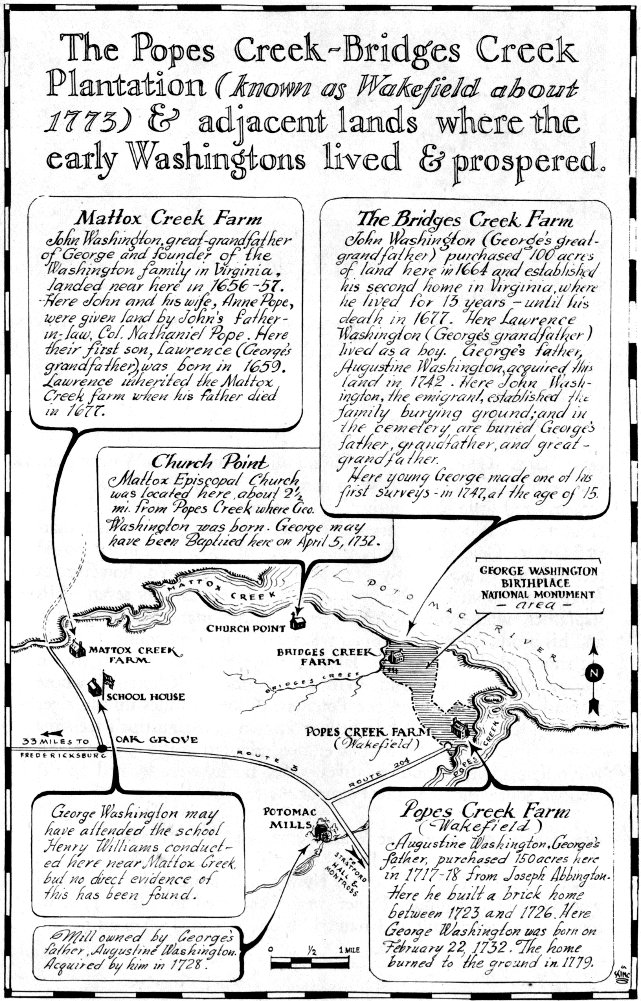
The Popes Creek-Bridges Creek Plantation (known as Wakefield about 1773) & adjacent lands where the early Washingtons lived & prospered.
GEORGE WASHINGTON BIRTHPLACE NATIONAL MONUMENT
—area—
Mattox Creek Farm
John Washington, great-grandfather of George and founder of the Washington family in Virginia, landed near here in 1656-57. Here John and his wife, Anne Pope, were given land by John’s father-in-law, Col. Nathaniel Pope. Here their first son, Lawrence (George’s grandfather), was born in 1659. Lawrence inherited the Mattox Creek farm when his father died in 1677.
The Bridges Creek Farm
John Washington (George’s great-grandfather) purchased 100 acres of land here in 1664 and established his second home in Virginia, where he lived for 15 years—until his death in 1677. Here Lawrence Washington (George’s grandfather) lived as a boy. George’s father, Augustine Washington, acquired the land in 1742. Here John Washington, the emigrant, established the family burying ground; and in the cemetery are buried George’s father, grandfather, and great-grandfather.
Here young George made one of his first surveys—in 1747, at the age of 15.
Church Point
Mattox Episcopal Church was located here about 2½ mi. from Popes Creek where Geo. Washington was born. George may have been Baptized here on April 5, 1752.
SCHOOL HOUSE
George Washington may have attended the school Henry Williams conducted here near Mattox Creek, but no direct evidence of this has been found.
POTOMAC MILLS
Mill owned by George’s father, Augustine Washington. Acquired by him in 1728.
Popes Creek Farm
(Wakefield)
Augustine Washington, George’s father, purchased 150 acres here in 1717-18 from Joseph Abbington. Here he built a brick home between 1723 and 1726. Here George Washington was born on February 22, 1732. The home burned to the ground in 1779.

Part of the court record in a suit over the building of Washington’s birthplace. From Westmoreland Records and Inventories, 1723-46.
Augustine Washington
EARLY LIFE.
George Washington’s father, Augustine Washington, was born at Mattox Creek, Westmoreland County, Va., in 1694. He remembered little of his father, as Lawrence Washington died when Augustine was only 4 years old. Two years later his mother married George Gale, and during the autumn of 1700, the family moved to England. Their family life abroad was short-lived, however, as Augustine’s mother died a year later, when he was only seven. His stepfather, who seems to have been a kindly man, sent Augustine and his brother, John, to Appelby School. Their schooling, too, was cut short, for a year or two later the boys returned to Virginia to live with their elder cousin, John Washington of “Chotank,” whose plantation was located on the Potomac, about 20 miles up the river from Bridges Creek. While little is known of Augustine’s teen-age activities one can surmise that he enjoyed plantation life to the utmost while living with various relatives whose farms were located on the wooded south shore of the Potomac River.
FIRST MARRIAGE.
Augustine Washington became of age in 1715, and shortly thereafter married Jane Butler, daughter of Caleb Butler, a successful Westmoreland County lawyer and planter. Four children were born of this union: Butler, 1716 (who died in infancy); Lawrence, 1718 (who built and named Mount Vernon); Augustine, Jr., 1719 or 1720; and Jane, 1722.
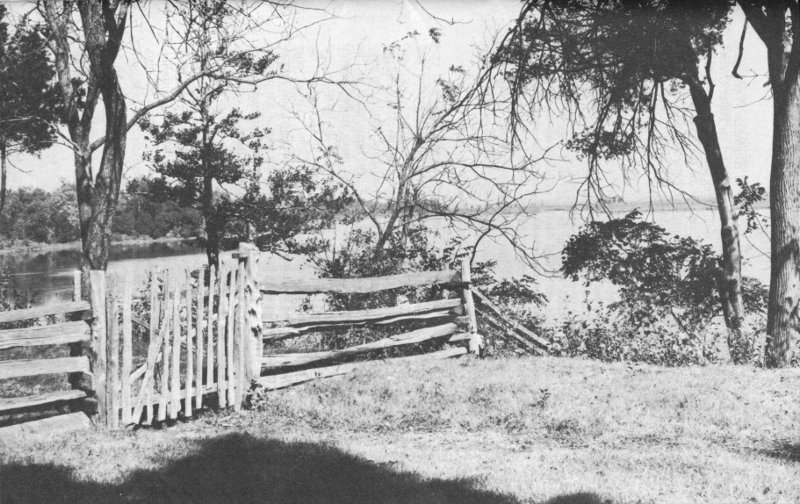
Popes Creek.
PURCHASE OF POPES CREEK FARM.
In 1717-18 Augustine Washington bought from Joseph Abbington 150 acres of land on Popes Creek—a beautiful tract overlooking the tidal creek and the Potomac River. Popes Creek, running along the east side of the tract, was approximately one-half mile wide, and joined the Potomac half-a-mile away. From Augustine’s land the river could be seen clearly, as it was over 5 miles wide from the Virginia side to the distant Maryland shore. Augustine’s historic piece of property is described in Westmoreland Deeds and Wills:
All that one hundred and fifty acres of lands scituate in the said County of Westmoreland aforesd and bounded Viz. Beginning at a marked hiccory on the head of the dancing marsh and so running down the said line to Popes Creek thence up the said Creek to the line of Nathaniel Washingtons and then up that line to include the aforesd One hundred and fifty acres of land which was given to Lawrence Abbington & his daughter Lydia Abbington together....
The tract probably included Joseph Abbington’s home, for the purchase covered “all houses, edifices, buildings, tobacco houses, fences, orchards, and gardens.”
BUILDING THE BIRTHPLACE HOME.
Some time between 1723 and 1725 Augustine Washington hired David Jones, a local carpenter and undertaker, to build a house on his Popes Creek property for 5,000 pounds of tobacco with extra amounts in cash for incidentals. The late Charles A. Hoppin, authority on the Washington family, believed that George’s father had the brick for his new home made on the plantation grounds, the foundations built, and many timbers hewed for the building before Jones began construction of the house. Jones also contracted to build for Augustine “2 bedsteads,” “1 cradle,” “2 Mantoll [mantel]pieces,” and “a small Poplar Table.” David Jones died in 1725, before the Washington house was completed, and Augustine entered a claim against his estate asking the sum of 500 pounds of tobacco. It may be inferred that the home was completed in 1726 and was about 6 years old at the time of George’s birth.
THE BIRTHPLACE.
While little is known about the appearance of the home in which George was born, the foundations and cellar floors uncovered during archeological excavations revealed that it was built either partially or entirely of brick. Several foundations of outbuildings were unearthed, and all were constructed of brick. So, also, all walls, cellar stairways, wine vaults, and fireplaces that have been excavated were built of brick.
The location of the new home was superb, being on a rise of ground 26 feet above Popes Creek and a little over 200 feet inland from its high western bank. To the east and northeast were pretty water 13 views; to the north, beyond cleared fields, was Dancing Marsh, green with lush grass and swamp plants; and to the southeast, 100 yards or so away, was a little peninsula which jutted out into Popes Creek (now heavily wooded with a beautiful grove of eastern redcedar, Juniperus virginiana). To the west of the house were pastures and cleared fields, and beyond the clearings was the dense forest—a mixed stand of broadleaf trees and evergreens. A farm road ran in a northwesterly direction for a mile or so, passing by the family burying ground where rested Augustine’s father and grandfather and other early members of the family. A short distance beyond the burying ground the road came to an end at the sandy south shore of the Potomac River.
The new home must have been rather commodious for a 1762 inventory of its furnishings lists 10 bedsteads, 13 tables, 57 chairs, 8 mirrors, 8 chests, accessories for 8 fireplaces, and scores of other furnishings and household items befitting a fairly large establishment. Certainly, the house in which George was born could not have been the humble 1-story clapboard structure portrayed in 19th-century imaginative sketches by artists who probably knew little about the social and economic status of George’s father.
Though not a man of great wealth, Augustine was able to send two sons to England for schooling. Early 18th-century objects unearthed near the foundations of his Popes Creek home, offer ample proof that he imported fine quality silver, pewter, glassware, and pottery from the mother country, and could afford to have his monogram stamped on his wine bottles. He was a man of some influence in his community, having held at various times the positions of justice of Westmoreland County Court, captain in the county militia, sheriff of Westmoreland County, and a vestryman of his church. He was part-owner of two iron-furnaces—Accokeek in Virginia and Principio in Maryland—and was financially able to visit England on two occassions to deal directly with his partners. He owned land and buildings in 3 Virginia counties and was master of at least 49 slaves. Though not as wealthy as certain other planters in the Northern Neck (the tidewater counties lying between the Potomac and Rappahannock Rivers), he was a man of good social standing.

Photocopy of the signature of Augustine Washington, father of George. From Westmoreland Court Orders, 1731-39.
Jane Butler Washington did not enjoy the new Popes Creek home many years, for in 1729 (when only 30) she died, leaving Augustine with the care of the 3 children. Lawrence, the eldest, was only 11.
SECOND MARRIAGE.
Sixteen months after Jane’s death, Augustine married another young lady from the Northern Neck, Mary Ball, on March 6, 1731. Mary was born at “Epping Forest” in Lancaster County, and was left an orphan at the age of 12. Between that time and the day of her marriage to Augustine Washington (when she was 23) she had lived with two prominent Westmoreland County families—the George Eskridges and the Samuel Bonums. George Eskridge, a kindly guardian, was like a real father to Mary and it is believed that she later named her first-born child after him.
Following her marriage to Augustine, Mary moved to his Popes Creek home where his 3 children were in need of their new mother. She soon gained the respect of her stepchildren—Lawrence 13, Augustine 12, and Jane about 9. Accustomed to farm life, Mary quickly assumed her new duties as mistress and manager of the household, and time passed quickly for her.
As February 1732 approached, Augustine and Mary Washington knew that their first son or daughter soon was to join the family. What they did not know was that their beloved first born would be a son who, one day, would become the first President of the United States of America—an office and a nation not yet dreamed of by any man. They did not know that their tiny son’s deeds and character would, in time, make him an immortal figure in the history of the new nation. Nor did they know that, before 200 years would pass, a city given his name would be the capital of a great World Power.
VIRGINIA IN 1732.
In 1732, 125 years had passed since the founding at Jamestown of the first successful English colony in America. The county of Westmoreland had been established for 79 years, and three-quarters of a century had gone by since Augustine’s grandfather, John Washington, had settled in Virginia. Williamsburg had been the capital of the colony for 33 years, and William and Mary College was in its 40th year. Some of Augustine’s older friends remembered Bacon’s Rebellion, which had flared up and had been extinguished by Governor Berkeley 56 years earlier. Augustine himself certainly remembered news of the fight between Blackbeard’s pirates and Virginia sailors, for only 14 years had gone by since the ruthless pirate leader had been killed off Ocracoke Island on the Outer Banks of North Carolina. Augustine also remembered accounts of the expedition Governor Spotswood had led to the distant Blue Ridge Mountains in 1716, for this adventuresome exploit was still discussed by the tidewater planters who coveted the little-known lands beyond the distant mountains.

Washington family coat of arms.
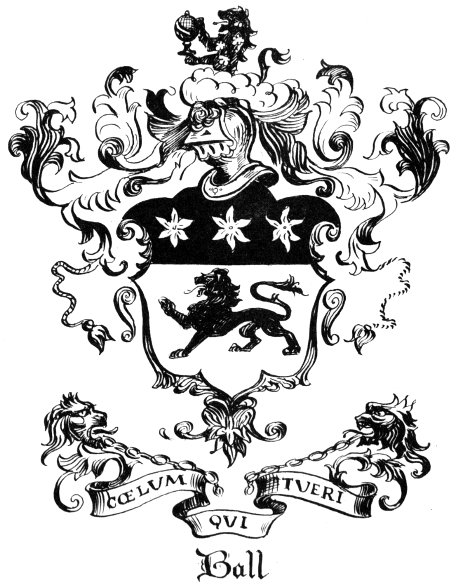
Ball family coat of arms.
There were only two towns in Virginia of any considerable size—Williamsburg and Norfolk—by 1732. The population of the colony was estimated at 114,000, of which 76,000 were whites and 38,000 Negroes. George Gooch was Lieutenant Governor of the Royal Province and George II was in the 6th year of his reign.
In 1732 William Byrd of “Westover” and Peter Jones were surveying the North Carolina-Virginia boundary line, and another year was to go by before Petersburg and Richmond would be laid out as townsites. There was not a single newspaper in Virginia in 1732; Augustine may have read The Maryland Gazette (published in Annapolis by W. Parks at 15 shillings a year) or one printed in London.
Tobacco was the important money crop, and almost every ship that sailed from a plantation wharf carried hogsheads of the “delightful weed” in its hold. Many other commodities, too, were shipped to the mother country as well as to New England, the middle colonies, Barbados, Madeira, Bermuda, and Jamaica. Exports from one Virginia shipping district—Porth South Potomac—in 1732 included (besides tobacco) staves, timber, corn, wheat, peas, beans, masts, pig iron, feathers, pork, cotton, earthenware “parcels,” woodenware “parcels,” bacon, hides, deerskins, beaver skins, oak and walnut logs, cider and cider casks, beef, wine pipes, snakeroot, tallow, pewter and brass “parcels,” and copper ore casks. Items imported included rum, salt, Irish linen, fish, chocolate, molasses, sugar, earthernware, “woodware,” millstones, Madeira wine, cheese, rice, ironware, and “parcels from Great Britain.” The latter “parcels” included furniture fabrics, rugs, pottery and porcelain, silver, pewter, copper and brassware, and other household furnishings and accessories needed by the colonists.
George Washington
On February 11 (Old Style), 1732—when jasmine and jonquils were beginning to bloom and dark purple berries were forming on the native “cedar” trees—Mary Ball Washington gave birth to her first child, a boy she named George. The time was about 10 o’clock in the morning. At a later date the event was recorded with brevity in the family Bible:
George Washington son to Augustine & Mary his Wife was Born ye 11th Day of February 1731/2 about 10 in the Morning & was Baptis’d the 5th of April following Mr. Beverley Whiting & Capt Christopher Brookes godfathers and Mrs. Mildred Gregory godmother.
The date, “11th Day of February,” was “Old Style.” By the Gregorian calendar, adopted by Great Britain in 1752 and now in use in the United States, the date was February 22, 1732, “New Style.”
The place where George was baptized on the 5th of April is unknown, 17 although the christening probably took place in the Popes Creek home. If not there, it may have occurred at Mattox Church (located at Church Point about 2½ miles away) or at Round Hill Church about 16 miles from the Popes Creek home by road. The Reverend Roderick McCullough was the minister in charge of the Episcopal churches in Washington Parish in 1732, but of his actual administering of the rite there is no record.
Very little is known about the godparents. A Beverley Whiting served as a burgess from Gloucester County, and a Christopher Brooke was captain of a Virginia ship, the Cambridge, but there is no evidence that these men were the ones, with similar names, recorded in the family Bible. The godmother, Mildred Washington Gregory, was George’s aunt.
The first 3½ years of George’s life were spent at the Popes Creek plantation. At some unknown date between March 25 and November 18, 1735, Augustine Washington moved his family up the Potomac River about 50 miles to his farm on Hunting Creek (known today as Mount Vernon). Three years later Augustine purchased a 288-acre farm near Fredericksburg, and about December 1, 1738 (when George was almost 7 years old) moved there with his family.
In 1742 Augustine acquired another tract of land between Popes Creek and Bridges Creek—within sight of the home where George was born. With the exception of one piece of property on the river all of the Popes Creek—Bridges Creek peninsula was now owned by George’s father.
In 1743, a few weeks after George’s 11th birthday, Augustine Washington was stricken with a stomach disorder, and died on the 12th of April. He was interred in the family burying ground at Bridges Creek, where his father, Lawrence, and grandfather, John, were buried. Augustine left the Popes Creek—Bridges Creek plantation to his second son and namesake, Augustine, Jr. (one of George’s elder half brothers).
After his father’s death it appears that George resided variously with his mother on her farm near Fredericksburg; at Mount Vernon with another half brother, Lawrence; at “Chotank” in King George County with other relatives; and at his birth home on Popes Creek with his elder half brother, Augustine, Jr.
The frequency and length of these visits of George to Popes Creek are not known, but there is ample evidence that he stayed with his elder brother and sister-in-law on many occasions for long periods. During such visits he must have become familiar with every nook and cranny in his birth home, as well as with its outdoor attractions—the green fields of tobacco, corn, and wheat; the sweet-scented herb garden; the domestic animals, and other aspects of farm life beloved by all boys fortunate enough to know them.

Survey of Bridges Creek area by George Washington at the age of 15.
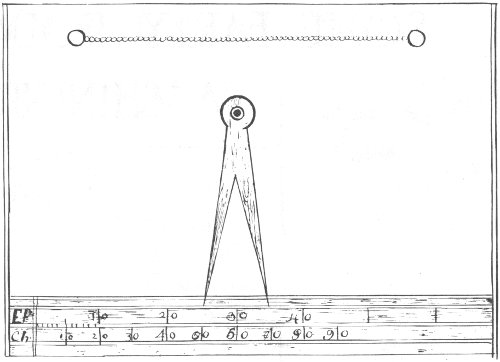
A copy of a chain, compass, and scale drawn by George Washington when he was 14 years old.
Beyond the cultivated fields grew the dense forest, which only a century before had been the hunting ground of the Indians. The dominant trees in the majestic woods were the broadleaf species—oak, maple, walnut, hickory, chestnut, holly, dogwood, persimmon, and tulip-poplar—interspersed with a few conifers, including cedar and several species of pine. Wild animals were abundant and young George probably hunted deer, bear, turkey, and other woodland creatures.
Tranquil Popes Creek must have had a special appeal to the growing boy, for along its edge, ducks and wild geese searched for food, and in its waters swam large turtles and many kinds of fish. More inviting than the creek, however, was the broad Potomac River—an invitation to fish, swim, and sail boat.
All was not play at the Popes Creek plantation. For when George visited his elder brother he undoubtedly helped with the numerous farm chores. Then, too, he may have attended the school Henry Williams conducted near Mattox Creek, although no direct evidence of this has been found. There is, however, reliable evidence that he mastered his first lessons in surveying while visiting his birthplace, for an existing survey of the Bridges Creek area was made by George in 1747, when he was only 15 years old.

SOME EARLY FOUNDATIONS UNEARTHED at WASHINGTON’S BIRTHPLACE
12′×12′ Foundation of 17th century building located ¼ mile northeast of the Washington Family burying ground. Believed to be a building constructed by Henry Brooks, who patented the land in 1657. Excavated in 1934.
WASHINGTON FAMILY BURYING GROUND
20′×14′ Foundation of building unearthed 180 feet southeast of Washington family burying ground, Bridges Creek, 1930 and 34. The structure—on land acquired in 1664 by John Washington (George’s great-grandfather)—was probably an outbuilding.
21′×36′ Foundation of early 18th century building unearthed by the War Department in 1896, traditionally the one in which George Washington was born in 1732.
Source—From a “Map Showing foundation of the Wakefield Mansion—Where tradition affirms Washington was born”. Map drawn by John Stewart, C.E., 1896
KITCHEN
Foundation of early 18th century chimney unearthed in 1896.
14′×14′ Foundation of early 18th century building (probably a smokehouse) unearthed by the National Park Service in 1936.
COLONIAL GARDEN
Foundation of small brick structure unearthed in 1936. Use of structure unknown.
30′×58′ Foundation of old structure known as building “X.” Uncovered by National Park Service in 1930. Re-excavated 1936.

Drawn by George Washington in 1750 (copy)
It is not known when George left the Popes Creek plantation for the last time as a youth, but he must have departed with a touch of sadness. The joys and pleasures of life on such a busy and beautiful tidewater plantation must have been unforgettable to the tall, teenage boy.
The Disastrous Fire
George’s elder half brother, Augustine Washington, Jr., the second owner of the Popes Creek home, died in 1762. The plantation passed to his son, William Augustine Washington, George’s eldest nephew. William Augustine took title in full in 1774 when his mother, Ann Washington (who had a dower life interest in the estate), died. About this time the Popes Creek plantation, for the first time, was called “Wakefield,” a name said to have been inspired by Oliver Goldsmith’s Vicar of Wakefield, and which has endured.
During the latter part of the American Revolution, when General Washington was leading the Continental Army in the north, his birth home in faraway Virginia caught fire and burned to the ground. Indirect evidence and tradition indicate that the house was destroyed Christmas Day, 1779. At the time of the fire the structure was owned by its third and last owner, William Augustine Washington. According to his daughter, Sarah Tayloe Washington, her father noticed the roof burning while returning from a ride. It is believed that a 23 spark from the chimney blew through the small garret window and set fire to the house. The home which had sheltered three generations of Washingtons for half a century was never rebuilt by them.
A Century of Neglect
After the disastrous fire at Wakefield, 36 years passed before the birthsite was marked. Finally, in 1815, George Washington Parke Custis (a grandson of Martha Washington and a ward of George Washington) visited Popes Creek and, in an imposing ceremony, marked what he considered to be the spot. Custis, in a letter to the editor of the Alexandria Gazette, described his visit in the following language:
In June, 1815, I sailed on my vessel, the “Lady of the Lake”, a fine topsail schooner of ninety tons, accompanied by two gentlemen, Messrs. Lewis and Grimes, bound to Popes Creek in the County of Westmoreland, carrying with us a slab of freestone, having the following inscription:
“Here
The 11th of February, 1732, (Old Style)
George Washington
Was Born.”We anchored some distance from the land, and taking to our boats, we soon reached the mouth of Pope’s or Bridge’s Creek, and proceeding upwards we fell in with McKenzie Beverly, Esq., and several gentlemen composing a fishing party, and also with the overseer of the property that formed the object of our visit. We were kindly received by these individuals, and escorted to the spot, where a few scattered bricks alone marked the birthplace of the chief.
Desirous of making the ceremonial of depositing the stone as imposing as circumstances would permit, we enveloped it in the “star spangled banner” of our country, and it was borne to its resting place in the arms of the descendants of four revolutionary patriots and soldiers.
We gathered together the bricks of an ancient chimney that once formed the hearth around which Washington in his infancy had played, and constructed a rude kind of pedestal, on which we reverently placed the FIRST STONE commending it to the respect and protection of the American people in general, and the citizens of Westmoreland County in particular.
Bidding adieu to those who had received us so kindly, we re-embarked, and hoisted our colors, and being provided with a piece of cannon and suitable ammunition, we fired a salute, awakening the echoes that had slept for ages around the hallowed spot.
Custis’ visit to Washington’s birthplace is important for two reasons. First, the freestone slab which he placed at the birthsite was one of the earliest monuments erected in the United States as a memorial to George Washington. Secondly, Custis describes the site as it appeared 24 in 1815 as a “spot where a few scattered bricks alone marked the birthplace of the chief.”
In 1832, the 100th anniversary of Washington’s birth, the Alexandria Gazette noted how the nation had forgotten the ancient Popes Creek farm: “It is surprising that it [Wakefield] should be so little known and visited. Not one in a thousand of the passengers in Steamboats had any knowledge that this ‘solum natale,’ of him whom the whole world honors, is remote but a mile over the waters surface; and hid from his view only by a fringe of wild shrubbery. Will not Wakefield like Mt. Vernon, in after time, be the resort of Patriotic Pilgrims?”
In the July 1833 issue of The North American Magazine an unknown contributor gives a bit of important information about the birth home: “The old house of his [Washington’s] birth has long since mouldered. The cellar over which it stood, now mostly filled up, is about fifty feet in length from east to west, having what seems to be a wine vault in the corner. An orchard of apple trees of modern growth interspersed with other fruit trees, surrounds the old cellar; westerly of which are scattered some apple trees of a very ancient growth, with fruit of a delicious flavour. These trees are monuments of olden times; contemporaries probably with the childhood of the Great Statesman.”
As the years passed during the 19th century, others who visited Washington’s birthplace commented on the neglected condition of the site. James K. Paulding of New York, a friend of Washington Irving and author of A Life of Washington, described Wakefield in 1835 as a place where “A few scanty relics alone remain to mark the spot.... A clump of old decayed fig trees, probably coeval with the mansion, yet exists; a number of vines, and shrubs, and flowers still reproduce themselves every year as if to mark the spot.”
In 1851 the Richmond Whig and Public Advertiser observed: “The birthplace of George Washington is ... marked only by an old brick chimney, a mammoth fig tree, and a freestone slab.... The slab is broken in two.... The neglected condition of the spot bears shame against his country for neglecting to lift up a monument there, to his memory.”
Five years later, in 1856, Bishop William Meade visited Wakefield and found Custis’ freestone slab broken into fragments. The Bishop wrote: “I recently paid a visit to the old family seat of the Washingtons.... The brick chimney is all that remains of the Washington mansion ... except the broken bricks which are scattered about over the spot where it was built. The grandson of Mrs. General Washington, Mr. Custis, of Arlington, some years since placed a slab with a brief inscription on the spot, but it is now in fragments.” The same year Bishop Meade visited Wakefield, Lewis W. Washington offered to the State of Virginia “sixty feet square of ground on which the house stood in which General Washington was born” together with the family burying ground, provided “that the State shall cause the premises to be permanently enclosed by an iron fence, based on a stone foundation, and shall mark the same by suitable, and modest, though substantial tablets, to commemorate for the rising generation these notable spots.”

The old kitchen chimney at Wakefield in 1872, the last surviving structure. It fell the next year. From a painting made by Sarah Pierrpont Barnard in 1872.
Gov. Henry A. Wise was greatly interested in the offer, and visited Westmoreland County on April 27, 1858, for the purpose of inspecting the birthplace site and the Washington family burying ground. As a result of his visit and consequent recommendations, the Commonwealth of Virginia accepted the donation and appropriated $5,000 to carry out the wishes of Lewis W. Washington. Before the protective steps could be carried out, however, the drumbeats of war were echoing across the land, and only the ancient fig trees and wild shrubbery continued to mark the venerable spot.
Five years after the Civil War, a visitor to Wakefield observed that the freestone slab which George Washington Parke Custis had placed over the presumed birthsite with such loving care had disappeared. It had remained there only about 55 years before falling a victim to the vandalism of that time.
Some time in 1873 the old kitchen chimney, which had withstood the ravages of the elements for a century and a half, finally collapsed and fell to the ground. It had stood above ground longer than any other part of Augustine Washington’s plantation buildings which he had built in the 1720’s on Popes Creek.

Ruins of the old kitchen chimney at Wakefield. From a sketch made by Charles C. Perkins in 1879.
The Saving of Washington’s Birthplace
The saving of Washington’s Birthplace was the work of many individuals and organizations, the Commonwealth of Virginia, the Wakefield National Memorial Association, and the United States Government.
In 1859 John E. Wilson, owner of most of the Popes Creek-Bridges Creek land, deeded to the Commonwealth of Virginia a right-of-way through his farm to the birthsite and the Washington family burying ground, together with one-half acre of land near the latter place and about 1 acre near the birthsite.
In 1882 the Commonwealth of Virginia vested title in the United States of America to its holdings at the birthsite and burying ground. By an act of Congress approved in 1879, and amended in 1881, the construction of a monument to mark the birthsite and the acquisition of the necessary ground and right-of-way had been authorized. In 1883 Mr. and Mrs. John. E. Wilson sold to the United States nearly 12 acres of land surrounding the birthsite and 9.85 acres constituting a right-of-way 50 feet wide and 1.6 miles long, connecting the birthsite, the family burying ground, and the Potomac River near the mouth of Bridges Creek.
Although Congress had authorized the construction of a monument to mark the birthsite in 1881, 15 years passed before the shaft of Vermont granite was erected. It was a time in our Nation’s history when historical conservation was crowded into the background in favor of more materialistic aims.
In the 1920’s a group of public-spirited women became interested in the old Washington family plantation. They wanted more than a granite monument to memorialize the site where our first President was born, and dreamed of a restored tidewater plantation. On February 23, 1923, under the able leadership of Mrs. Josephine Wheelright Rust, they organized the Wakefield National Memorial Association. Their main objective was to restore the Wakefield plantation and make it a shrine for all people, the date set for completion of the task was 1932—the 200th anniversary of Washington’s birth.
Shortly after the Wakefield National Memorial Association was incorporated in 1924, its members raised funds for acquiring land between the birthsite and the Washington family burying ground, and induced John D. Rockefeller, Jr., to purchase 273 acres of the old Wakefield plantation and transfer it to the United States Government. By an act of Congress, approved June 7, 1926, the association was given authority to construct a house at Wakefield as nearly as possible like the one built by Augustine Washington. In 1929 the association acquired additional land, and 2 years later donated its holding at Wakefield (about 100 acres) to the United States.

The walk from the colonial-style garden to the memorial house.
By an act of Congress on January 23, 1930, the 394.47 acres owned by the Federal Government was designated as George Washington Birthplace National Monument, to be administered by the National Park Service of the United States Department of the Interior.
In 1930-31 the Wakefield National Memorial Association, under its authority from Congress, built an early 18th-century style brick home as a memorial to mark the approximate site of the home in which George Washington was born. (The granite shaft which had marked the site since 1896 was moved to a new location.) As intensive research had produced very little reliable evidence concerning the appearance of the original Popes Creek home, the memorial house erected could not be a replica. It is, however, in keeping with the Virginia plantation scene at the time of Washington’s association with the place.
The new memorial house was opened to the public in July 1931, and a special open house was held on February 22, 1932, the 200th anniversary of George Washington’s birth. Since then the Wakefield National Memorial Association has been active in furnishing the home with suitable pieces of the 1700-50 period. In many instances 18th-century artifacts unearthed near the site of the original home have served as guides in selecting certain items. The objects excavated were surprisingly varied and revealed the nature of many furnishings which were in the original home between the time it was completed in 1726 and the time of the disastrous fire in 1779. Only a few types of the more important artifacts unearthed can be described:
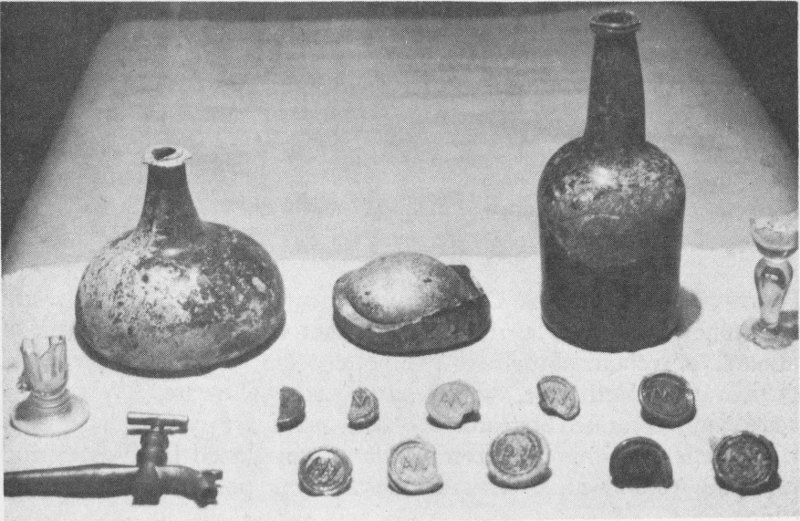
Wine bottles, glasses, seals, and bronze spigot of 1700-80 period found at Wakefield.

Fragments of kettle and spoons unearthed at Wakefield.
Glass.
Hundreds of pieces of broken wine bottles were found, including 11 wine bottle seals bearing the initials of George’s father, “AW”. During the 18th century only well-to-do planters imported wine bottles from England with their names or monograms stamped on the necks of the containers. Many wine-glass stems were also found, revealing the fine assortment of drinking glasses used by the Washingtons. Numerous windowpane fragments were unearthed.
Tableware.
Many bonehandled knives and forks of excellent quality were excavated, together with several types of pewter and latten metal spoons. A few of the knife and fork handles found were dyed green, described in the 1762 inventory as “green Ivory handled knives & forks.”
Furniture hardware.
Many brass upholstering tacks, knobs, drawer pulls, and keyhole escutcheons, which at one time embellished high quality English furniture of the 1725-75 period, were unearthed.
Clay pipes.
Hundreds of fragments of English white clay pipes were found in the vicinity of the birthsite.
Lighting devices and fireplace equipment.
Brass candlesticks, candlesnuffers, and brasshandled fireplace tools excavated revealed that the Washingtons imported fine metalware from the mother country.
Pottery and porcelain.
Countless fragments of colorful earthenware and stoneware pottery were found, together with a fine assortment of oriental porcelain. Much of the pottery (including slip-decorated earthenware, Delftware, white salt-glazed stoneware, “Whieldon” ware, hand-decorated Staffordshire, and creamware) was made in England; some was imported from Holland (tin-glazed Delftware) and Germany (stoneware), whereas most of the porcelain came from China.
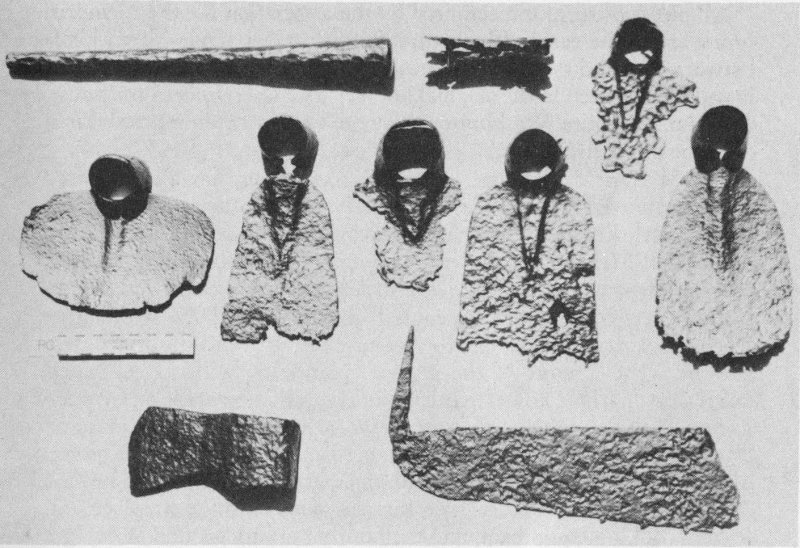
Tools unearthed near the site of the home in which George Washington was born—iron hoes, an iron pestle, small ax, and fragment of an ice saw. All tools shown date from 1690 to 1775.
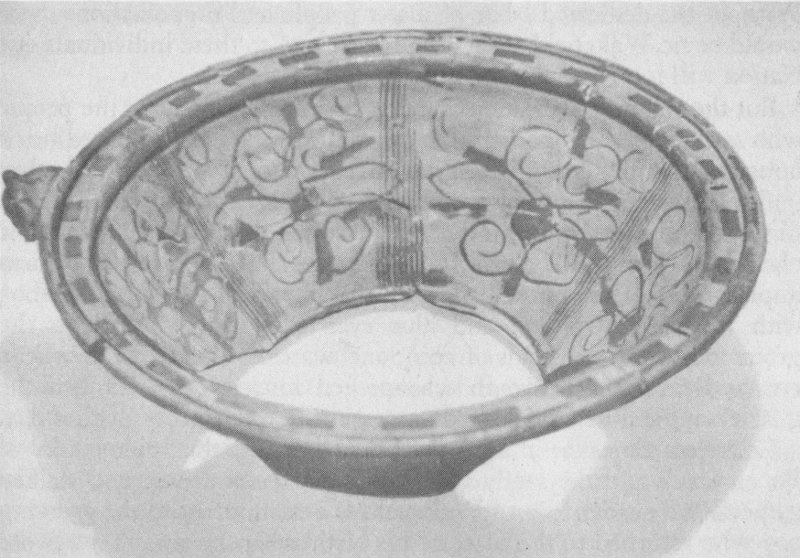
Sgraffito (scratched) earthenware bowl.
All pieces of furniture acquired by the association for the memorial house are of the early 18th-century English styles, having been made between 1700 and 1750. Only one item in the house, a tilt-top tea table, is said to have been in the original home. The last owner of the house, William Augustine Washington (George’s eldest nephew), saved it at the time of the fire in 1779.
The Wakefield National Memorial Association has also acquired appropriate cooking utensils of the early 18th-century period for the colonial-style kitchen. Once again, excavated artifacts—including pot-hooks, kettle fragments, skewers, ladles, and numerous other cooking accessories—were used as guides in locating suitable kitchen equipage.
Since 1932 over a million people from all parts of the world have visited Wakefield and enjoyed its natural beauties and historical associations. The serenity of the restored plantation with its cultivated fields and oldtime flower garden, its fragrant boxwood and sweet-scented herbs, and the lovely water views afforded by Popes Creek and the Potomac River, make unforgettable impressions. The memorial house furnished with beautiful and appropriate pieces from a bygone day, the early 18th-century style kitchen with its huge fireplace and ancient cooking equipment, and the family burying ground at Bridges Creek, almost 300 years old, are integral parts of the scene. In addition to these glimpses of colonial life are the well-kept grounds, the carefully tended flower beds, and the grove of native cedar trees which stand like venerable sentinels on Burnt House Point.
Such enchanting scenes which impress the senses and mind are taken for granted today, as few pilgrims realize that not so many years ago the birthplace of our Nation’s First Citizen was all but forgotten. Without the dedicated labor of many people and organizations there would be no Wakefield plantation today, and to these individuals our Nation will forever owe a debt of gratitude.
But the restored plantation is more than a monument to the people who saved it. It is a memorial to the boy who played in the red brick house by the tidal creek, in the stables, barns, tobacco sheds, and other outbuildings; in the smokehouse and summer kitchen; in the spinning and weaving house and buttery; and near the forge where the blacksmith beat red-hot iron rods into tools and hardware and farm implements. The restored plantation is a shrine to the young boy with reddish-brown hair and blue eyes who romped through the green meadows and fields of corn, and watched the growing wheat, rye, and tobacco; the youth who picked luscious figs, climbed the gnarled apple trees, and played games in the cedar grove of that day.
Countless times he must have walked along the high banks of Popes Creek and the sandy shore of the Potomac River, and stalked game in the nearby forest. Wakefield is a monument to the growing boy who returned to the place of his birth when he was 11 years old 33 and learned his first lessons in surveying. The impressions which the peaceful farm made on his mind were lasting ones, and as he grew from youth into manhood and assumed greater responsibilities, the happy memories of days spent on his father’s plantation were never forgotten.

The memorial house.
Guide To The Area
The information which follows, supplements that contained in the narrative of this handbook. It has been arranged to enable you to make your own tour of the area. The numbers given correspond to the numbers on the map of the national monument on pages 34-35.
1. Granite shaft.
This shaft, of Vermont granite, weighs about 50 tons. It is nearly one-tenth the size of the Washington Monument in the Nation’s capital, and of the same relative proportions. First erected in 1896 by the War Department (at or near the foundations of the home in which George Washington was born), it was moved to its present location near the entrance to the national monument in 1930.

GEORGE WASHINGTON BIRTHPLACE NATIONAL MONUMENT—Westmoreland County, Va.
- Points of interest within the National Monument area:
- 1 GRANITE MONUMENT
- 2 SUPERINTENDENT’S OFFICE
- 3 MAIN PARKING AREA
- 4 POST OFFICE
- 5 SITE OF BUILDING “X“
- 6 MEMORIAL HOUSE
- 7 COLONIAL STYLE GARDEN
- 8 GROVE OF NATIVE “CEDARS”
- 9 KITCHEN & HISTORICAL MUSEUM
- 10 SITE OF SMOKE HOUSE
- 11 DUCK HALL PICNIC AREA. (Parking)
- 12 SITE OF ANCIENT BUILDING FOUNDATION
- 13 WASHINGTON FAMILY BURIAL GROUND
- 14 POTOMAC RIVER VIEW

Tilt-top table in the dining room. The only piece of furniture in the memorial house believed to be from the home in which Washington was born.
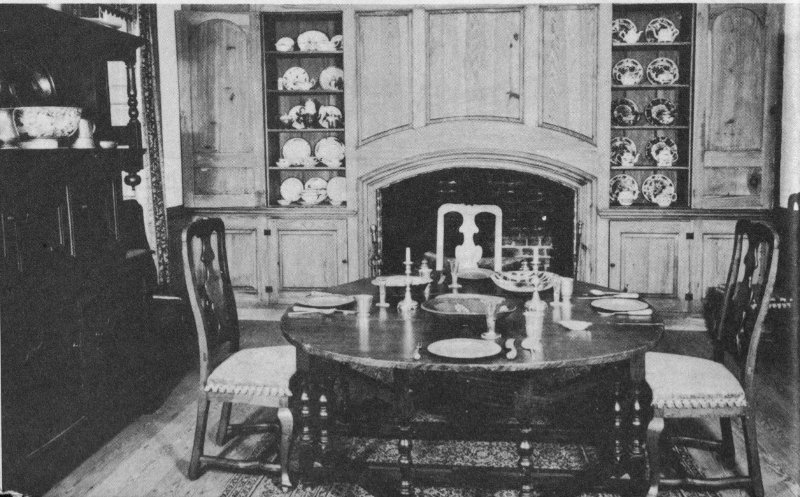
Dining room. Many of the items of tableware shown are similar to types unearthed at Washington’s birthplace.
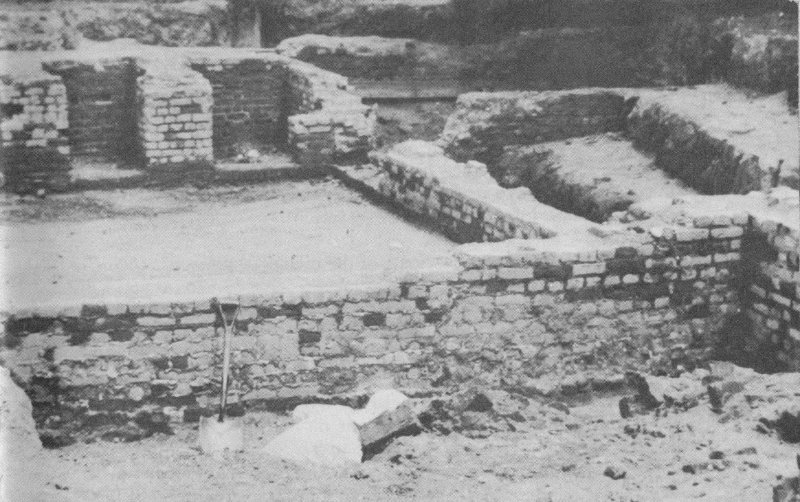
Brick foundations of a part of Building “X”, an early building unearthed at Washington’s birthplace.
2. Superintendent’s office.
Visitors seeking information are always welcome here.
3. Main parking area.
4. Post office, Washington’s Birthplace, Va.
Souvenirs, postcards, potted plants, and soft drinks may be purchased in the post office building.
5. Site of Building “X.”
So-called because its history is unknown, the brick foundations of Building “X” were discovered in 1930. They were partially unearthed that year, and completely excavated in 1936. The boxwood plants outline only one room of the building, known as Unit “A.” The brick foundations of Building “X” were the most extensive ones unearthed at Wakefield. Including the projecting wings, the foundations were almost 70 feet long. The center of the building was approximately 19 feet wide. One wing was 22 feet wide, the other 32 feet wide. The possibility that it, rather than the smaller foundation on the memorial mansion site about 60 feet away, was the exact spot where George Washington was born cannot be ignored and will perhaps always remain an intriguing question.
6. Memorial house.
This was built in 1930-31. The furnishings are of the 1700-50 period. One item, a tilt-top table, is the only existing piece of furniture said to have been in the original house at Wakefield, having been saved at the time of the fire in 1779. Much of the pottery, porcelain, glassware, tableware, and metalware in the house are similar in period and style to many of the artifacts which were unearthed near the birthsite during archeological excavations.
7. Colonial-style garden.
South of the memorial house is a colonial-type garden enclosed by a handsplit picket fence. It is connected with the memorial house by a boxwood-lined brick walk. The English boxwood is well over a century old, and was transplanted from the home, 8 miles away, of Sarah Tayloe Washington (a daughter of the last occupant and owner of the home in which George Washington was born.) It is believed to have grown from cuttings originally taken from Wakefield. In this fragrant, old-fashioned garden, will be found many plants that were common to Virginia gardens during the period of George Washington’s youth. Here are sweet-scented herbs such as sage, thyme, hyssop, wormwood, marjoram, rue, tansy, pennyroyal, basil, hoarhound, snakeroot, true lavender, caraway, and others used for cooking and medicinal purposes. Among the colorful flowers are old roses, hollyhocks, lilies, bleedinghearts, forget-me-nots, love-in-a-mist, narcissi, iris, and heliotrope.

A part of the parlor.
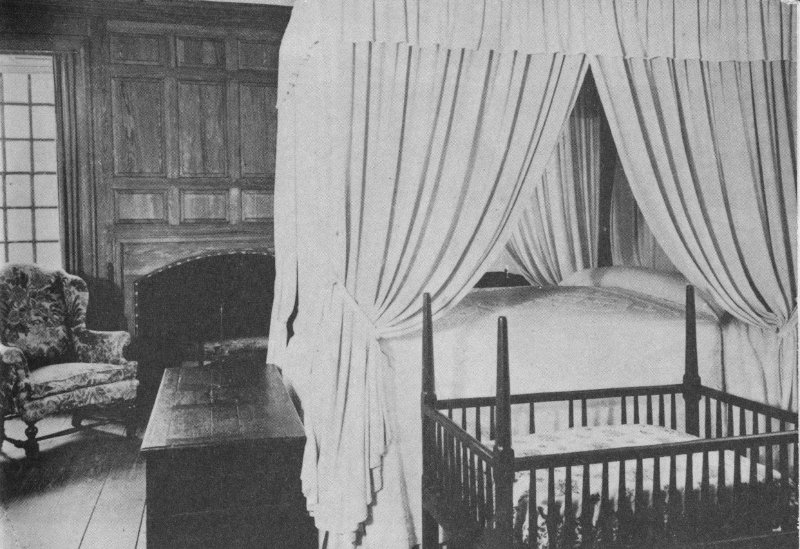
Master bedroom.
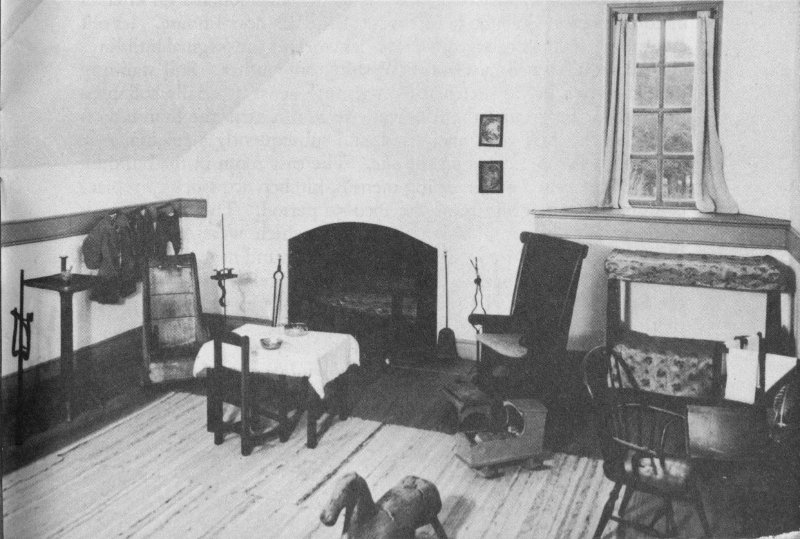
The children’s room.

Interior of reconstructed colonial kitchen.
8. Grove of eastern redcedars.
South of the colonial garden is a magnificent grove of eastern redcedars, Juniperus virginiana. The grove covers Burnt House Point, which juts out into Popes Creek.
9. The kitchen and historical museum.
The colonial-style kitchen building is located about 50 feet west of the memorial house. Its old chimney was the last above-ground brickwork of the original buildings at Wakefield owned by George Washington’s father. Still standing in 1872, when it was sketched by a visiting artist, it finally collapsed and fell to the ground the following year. In 1930 the foundations of the old kitchen were uncovered, and subsequently a colonial-style building was constructed on the site. The east room in the building has been furnished with cooking utensils, kitchen accessories, fireplace equipment, and furniture of the 1700-50 period. The west room is used for the display of colonial artifacts which were unearthed at Bridges Creek and from various foundations found near the site of the original home on Popes Creek. The exhibits relate to the history of the Bridges Creek and Popes Creek plantations as well as to the activities of the early Washingtons who lived there.
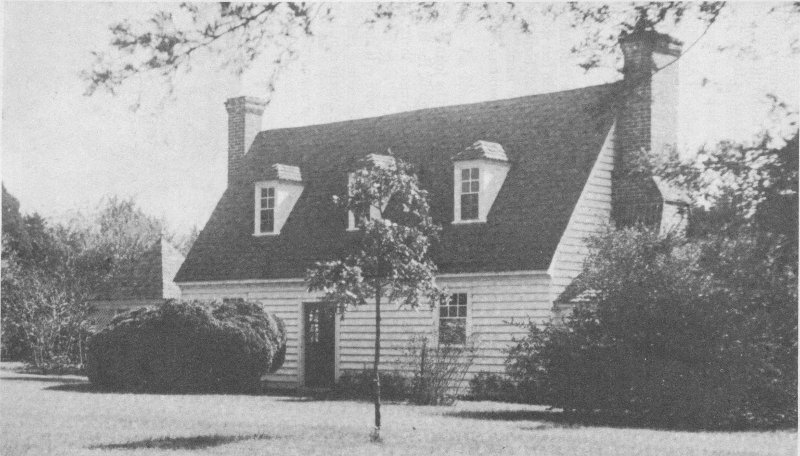
Colonial-type kitchen. One room is furnished as an 18th century kitchen; another room houses excavated objects and exhibits relating to the early Washingtons who lived at Bridges Creek and Popes Creek.
10. Site of smokehouse.
The boxwood plants mark the site of an old building foundation believed to be that of an early 18th-century smokehouse. Excavated in 1936, the building had brick foundations as well as a brick floor. The foundations were located about 65 feet west of the kitchen building.
11. Duck Hall parking and picnic area.
This section of the national monument is located approximately three-quarters of a mile northeast of the granite shaft. It may be reached over a paved road which runs north from the granite shaft for about one-fourth of a mile, then turns eastward. From the Duck Hall picnic area may be seen magnificent views of Popes Creek and the Potomac River.
12. Site of 17th-century brick building.
In 1934 brick foundations of a small 17th-century building were unearthed about 180 feet southeast of the Washington family burying ground. One glass bottle seal found near the building site was inscribed with the name “John Washington.” The structure was probably an outbuilding which belonged to George Washington’s great-grandfather.

Washington family burying ground.
13. Washington family burying ground.
Established by John Washington, the founder of the Washington family in Virginia, the family burying ground is located about 1 mile north of the granite shaft. In his will, John, the great-grandfather of George, asked “to be buried on ye plantation wheire I now live, by the side of my wife yt is already buried.” In the years that followed, members of succeeding generations of Washingtons found final resting place in the ancient cemetery. 43 Here the father, grandfather, and great-grandfather of George Washington, together with 29 other early members of the family, are interred. In 1906 the Colonial Dames of Virginia made some improvements at the burying ground. In 1930, under the auspices of the Wakefield National Memorial Association, the burying ground was enclosed by a wall of handmade bricks. Five new tablestones were erected and the area was appropriately landscaped. A parking area is located about 300 feet east of the burying ground.
The tract of land surrounding the burying ground was purchased by John Washington in 1664 from David Anderson. The site of his home is in the vicinity of the burying ground.
14. Potomac River view.
About a quarter of a mile north of the Washington family burying ground is the south shore of the Potomac River. Here may be seen a delightful view of the river, approximately 5 miles wide at this point. President James Monroe, the fifth President, was born on a farm facing the deep bay on the extreme left.
How To Reach the Monument
George Washington Birthplace is 72 miles south of Washington, D. C., via the Potomac River Bridge. It may also be reached from Washington by way of Mount Vernon and Fredericksburg, a distance of 83 miles. The national monument is 69 miles northeast of Richmond, by way of Bowling Green and Port Royal, or 75 miles via U. S. 360, and State Routes 3 and 204. It is 100 miles from Williamsburg and 123 miles from Norfolk over good roads. Washington’s Birthplace is on the Potomac River, and should not be confused with Wakefield, Va., which is in Sussex County, south of the James River.
About Your Visit
George Washington Birthplace National Monument is open from 8 a. m. to 5 p. m., Eastern Standard Time, every day of the year including Sundays and holidays, except Christmas and New Year’s Day. Admission to the area is 25 cents for adults. Children under 12 are admitted free. Special interpretive talks are given to school classes and other organized groups if arrangements are made in advance with the superintendent.
Soft drinks, postcards, potted plants, herbs, and souvenirs may be purchased at the Washington’s Birthplace Post Office, located at the main parking area.
Related Areas
There are several other areas in the eastern United States administered by the National Park Service which illustrate various aspects of George Washington’s life and public career. These include: Fort Necessity National Battlefield Site, Pa.; Independence National Historical Park, Pa. (which includes the Deshler-Morris House in Germantown, where Washington lived for a short while in 1793 and again in 1794); Morristown National Historical Park, N. J.; Colonial National Historical Park (including Yorktown), Va.; and Federal Hall National Memorial, N. Y.
Administration
George Washington Birthplace National Monument, now containing about 400 acres, was authorized by an act of Congress on January 23, 1930. It is administered by the National Park Service of the United States Department of the Interior. Communications concerning the national monument should be addressed to the superintendent whose address is Washington’s Birthplace, Westmoreland County, Va. Inquiries should not be sent to Wakefield, Va.
Suggested Readings
Eaton, David W. Historical Atlas of Westmoreland County, Virginia. Dietz Press. Richmond, Va. 1942.
Eubank, H. Ragland. Touring Historyland: The Authentic Guide Book of Historic Northern Neck of Virginia. Northern Neck Association. Colonial Beach, Va. 1934.
Fitzpatrick, John C. Writings of Washington. 39 vols. Government Printing Office. Washington, D. C. 1931-44.
Ford, Worthington C. Editor. The Writings of George Washington. The Washington Family, Appendix to Vol. 14. G. P. Putnam’s Sons. New York. 1893.
Freeman, Douglas Southall. George Washington, A Biography. Vol. I. Charles Scribner & Sons. New York. 1949.
Hoppin, Charles A. The Washington Ancestry and Records of the McClain, Johnson, and Forty Other Colonial American Families. Vol. I. Privately printed by Edward Lee McClain, Greenfield, Ohio, 1932.
Smith, H. Clifford. Sulgrave Manor and the Washingtons. Jonathan Cape. London. 1933.
U. S. GOVERNMENT PRINTING OFFICE: 1956 O—389002
NATIONAL PARK SERVICE
HISTORICAL HANDBOOK SERIES
FOR SALE BY THE SUPERINTENDENT OF DOCUMENTS, U. S. GOVERNMENT
PRINTING OFFICE, WASHINGTON 25, D. C.
- Bandelier (No. 23), 35 cents
- Chickamauga and Chattanooga Battlefields (No. 25), 25 cents
- Custer Battlefield (No. 1), 20 cents
- Custis-Lee Mansion (No. 6), 20 cents
- Fort Laramie (No. 20), 25 cents
- Fort McHenry (No. 5), 25 cents
- Fort Necessity (No. 19), 25 cents
- Fort Pulaski (No. 18), 25 cents
- Fort Raleigh (No. 16), 25 cents
- Fort Sumter (No. 12), 25 cents
- George Washington Birthplace (No. 26), 25 cents
- Gettysburg (No. 9), 25 cents
- Hopewell Village (No. 8), 25 cents
- Independence (No. 17), 25 cents
- Jamestown, Virginia (No. 2), 25 cents
- Kings Mountain (No. 22), 25 cents
- The Lincoln Museum and the House Where Lincoln Died (No. 3), 20 cents
- Manassas (Bull Run) (No. 15), 20 cents
- Morristown, A Military Capital of the Revolution (No. 7), 25 cents
- Ocmulgee (No. 24), 25 cents
- Petersburg Battlefields (No. 13), 30 cents
- Saratoga (No. 4), 20 cents
- Shiloh (No. 10), 25 cents
- Statue of Liberty (No. 11), 25 cents
- Vicksburg (No. 21), 25 cents
- Yorktown (No. 14), 25 cents

Copy of survey made by George Washington at the age of 16.
Surveying
A Plan of Major Larw. Washington’s Turnip Field as
Survey’d by me
This 27 Day of February 1747/. GW
Transcriber’s Notes
- Retained publication information from the printed edition: this eBook is public-domain in the country of publication.
- Corrected a few palpable typos.
- In the text versions only, text in italics is delimited by _underscores_.
Hellenica World - Scientific Library

